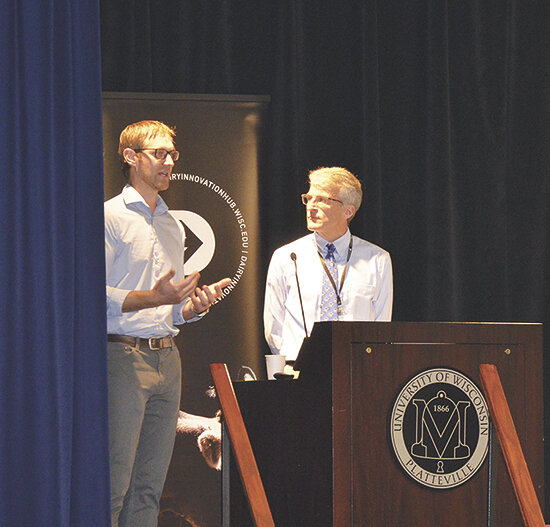
PLATTEVILLE, Wis. — Research to find a better solution for fencing managed grazing systems is underway through a collaborative effort between the Dairy Innovation Hub and Chris Wilson, an organic farmer from the Cuba City area.
The Dairy Innovation Hub is a state-funded research organization that encompasses resources from the University of Wisconsin in Madison, Platteville and River Falls. This year’s summit was hosted by the UW-Platteville Nov. 15 and featured research done on fencing options for dairy farms that utilize managed grazing.
Wilson and research professor Dr. Hal Evenson presented the research findings.
Wilson milks 500 cows and grazes them over 250 acres. His farm was used as a test point for the research due to its size and model.
Two approaches were taken when considering how to improve fencing options for grazing dairy farms, one being a physical barrier and the other being a virtual fencing model. The research for the project began in 2020, and Evenson said the students had big ideas to start with.
“Our goal was to come up with a cost-effective means to support rotational grazing at the scale of Chris’ farm,” Evenson said.
The research team first pursued a way to improve the physical barriers since the cows were already used to respecting a fence. The goal was to save the Wilsons the two-plus hours per day that they spent physically moving fencing with their all-terrain vehicles.
The research team set out to design a way for the physical fence to be moved automatically. They worked through a few prototypes and ended up with a motorized cart that could move the fencing to a determined area with the aid of GPS. The cart also had the potential to include sensors that would collect data on the herd as well as weather and terrain conditions that the herd experienced. The idea was to achieve a semi-automated system where the cart could go through preprogrammed GPS points.
“You get students onto something and you show them what was done before and they are bound and determined to do better,” Evenson said. “Especially industrial technology management students want to show that they can do better than the engineering students, so they built this one that looks like it could win a war.”
The team also researched virtual fencing possibilities. The idea was that the user could draw a map using a web browser interface and those coordinates could then be pushed to the herd by way of smart devices that would identify their location and dissuade them from traveling beyond the predetermined boundaries.
The obvious advantages for this idea were the labor savings from managing a physical fence and the lack of limitations from ravines or trees. There was also greater potential for data collection. The limitations included cost, complexity and power supply challenges.
The prototype included a GPS unit, battery pack and sound dissuasion to begin with, leaving the electric dissuasion option open. After two years of working on both the physical and virtual fencing possibilities, the prototypes were put to the test in the summer of 2022.
The automated cart prototype designed to improve the physical fencing was determined to be unfit for practical conditions. The wheels were too low to travel through the tall pasture grass and the motors were better equipped to travel across the university campus and not pasture terrain.
The virtual fencing devices were not practical because the collars were too bulky, and having to charge 500 devices every day proved to be impractical. Durability also created a problem since cows tend not to understand the fragility of such devices.
“It’s challenging to combine all these things,” Evenson said. “Ultimately, we realized that we were trying to put too many features together at once, and the truth was these things failed spectacularly.”
The team took a step back then and reevaluated what their goals and priorities were. They decided that data was paramount, implementation had to be easy, flexibility to move within multiple paddocks per day was key, and, above all, the cows had to be kept happy.
Going forward, they plan to expand on an existing technology called Ultra-wide Band. The concept includes anchor points that help define where a paddock is and then the cows each have a tag which communicates with those anchors so that they can figure out the relative position.
“As far as what we’re doing, we’re going with the standard tag design and kind of modularizing the system,” Evenson said. “I feel like now we’re on a good path, and if the technology is not there yet, we will be ready for it when it is.”
Comments
No comments on this item Please log in to comment by clicking here